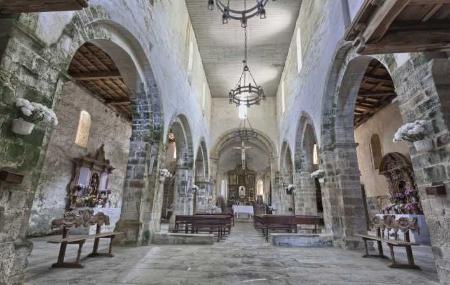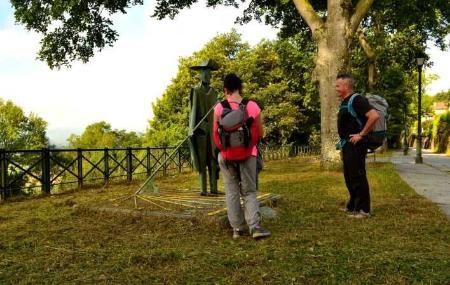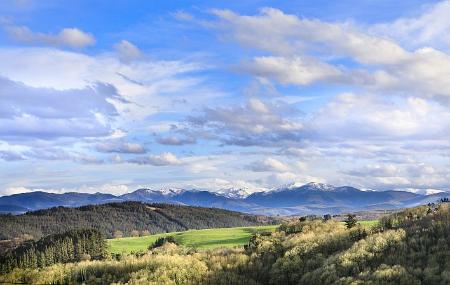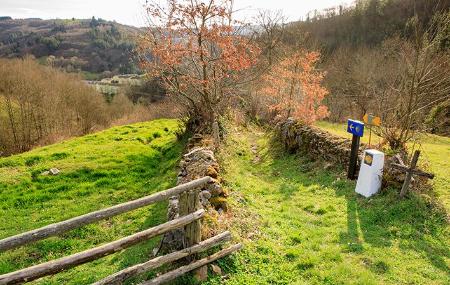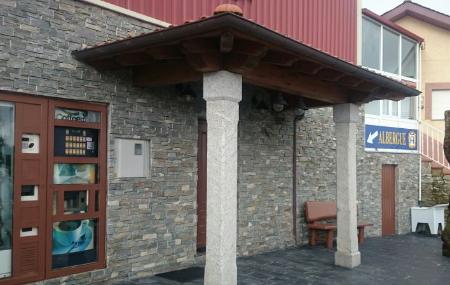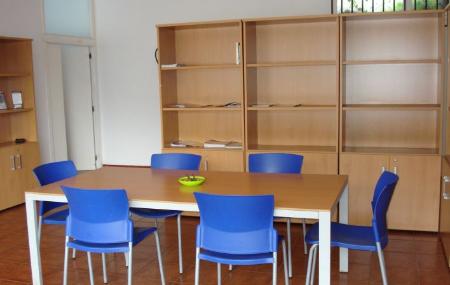Stage 4: Tinéu - Pola de Allande
27.9 Kms
This 27.46 km stage runs through the municipalities of Tineo and Allande, linking the capital cities of both municipalities.
The route is mostly on dirt and gravel tracks (some of which run parallel to modern local or regional roads).
In the first part of the itinerary, the route climbs from Tineo to the top of Piedratecha, over a distance of five kilometres, overcoming a drop of some two hundred metres, to then begin a steep descent of some 300 metres in three kilometres, after which the route continues without major incidents until the final climb, on the border between Tineo and Allande, to the top of Lavadoira, from where a steep descent begins towards the town of Pola de Allande.
This stage now enters fully into western Asturias, characterised by its slate-roofed buildings and small villages that mark out the Pilgrims' Route to Santiago, such as Vil.lal.luz, Vega del Rey, Campiel.lu, Bourres, Porciles and Ferrói, all of which are small villages dedicated to agriculture and livestock farming, where numerous traditional buildings and heritage elements of interest survive, such as small chapels and churches. Between the villages, the Way runs through meadows and wooded areas, and the route is often flanked by dry-stone walls.
The monastery of Santa María la Real de Obona, located just a few metres from the official route, stands out among the cultural heritage of the stage. It is one of the landmarks of the Primitive Asturian Way, so much so that in 1222 King Alfonso IX even ordered that this place should be an obligatory stop on the pilgrimage route to Compostela.
The towns of Tinéu and Pola de Allande also have notable examples of interesting architecture, with the palace of the Cienfuegos family standing out in the capital of Allande, which dominates the town from the hill on which it is located.
Documentary references indicate that the Pilgrim's Way to Santiago had a transcendental importance in the configuration of the territory through which this stage runs. Many villages owe their existence and their configuration to the passage of the Pilgrim's Way through them. Mention has already been made of the detour of the route imposed in 1222 to make it compulsory for pilgrims to pass through Oubona.
Furthermore, the first mention of a pilgrims' hospital along the Pilgrim's Way to Santiago is related to the hospital of Villarmil, located in the village of Bourres, and already mentioned in a document from 883. In Pola de Allande there was also a pilgrims' hospital, located in Cimadevilla, near the palace of the Cienfuegos.
Variant of the Hospitals:
Salas - Bourres:
This stage corresponds to a proposal to follow the Primitive Way if we take the Los Hospitales variant, between the municipalities of Tineo and Allande, dividing the route into two sections, this one between Salas and Bourres and the next one between this town and Berducedo, continuing the Way along a single route between Berducedo and the border with Galicia, at the Alto del Acebo.
The route included in this stage is described in the chapters dedicated to the Salas-Tineo and Tineo-Pola de Allande stages. It covers a distance of 32 kilometres, through the municipalities of Salas and Tineo.
The route maintains a clearly ascending profile from the exit of the town of Salas to the Alto de La Espina, on the border of the two municipalities. From here, it becomes more stable, with a significant but shorter ascent from the town of Tineo to the Piedrafita pass, from where it begins a gentle descent to the town of Bourres, the end of the stage.
The first pilgrims' hostel on the Pilgrims' Route to Santiago de Compostela is documented in Bourres, in the year 883, and in the 1990s the hospitality tradition of this village was revived thanks to a hostel located in the old schools.
More than half of the itinerary of this stage (around 14 km) runs on dirt and gravel tracks, while the asphalt surface is present in just over 10 km.
Bourres - Berducedo:
This is the second stage of the Hospitales variant, in which the Way itself enters this route through the Fonfaraón mountain range, on the border between the municipalities of Tineo and Allande.
On this route there is a difference in height of more than 500 m between the village of La Mortera and the top of the hospital, next to the ruins of the historic hospital of Fonfaraón, but it should be noted that this is a very logical natural path, which avoids steep ascending slopes, except in very specific sections, taking advantage of axial axes and half-slope climbs, so that in practice, until reaching the highest point at the top of the Palo, there are very frequent stretches that are practically flat or with very little incline.
The natural landscape is the main protagonist of this stage, characterised by a route of several kilometres in the middle of the mountain, with a succession of peaks that are crossed halfway up the slope, passing through fields and some lakes, always surrounded by wide views of the western Asturian landscape, sometimes breathtaking due to its amplitude and physiognomy.
The Hospitales path has a very long history, with many archaeological remains found in the surrounding area, many of them from old Roman mines, such as the La Freita mine, a spectacular sight from the Pilgrims' Route to Santiago de Compostela.
Along the route of the Hospitals, you will pass by the remains of the old establishments of assistance and aid to pilgrims, dating from the medieval period. Thus, you will flank the ruins of the hospital of Paradiella, that of Valparaíso (at the foot of the Santiellos and Pico Cimero peaks), that of Fonfaraón (nowadays a livestock hut, located in the line of summits of the Fonfaraón mountain range), and that of Fonfaraón (at the foot of the Hospital of Paradiella), at the foot of the high peak of the Hospital of Valparaíso (at the foot of the Hospital of Paradiella), at the foot of the Alto del Hospital, on the boundary between the municipalities of Tineo and Allande) and those of the Hospital de la Freita (near the pass of El Estreitín, close to the great Roman mining cut of La Freita).


